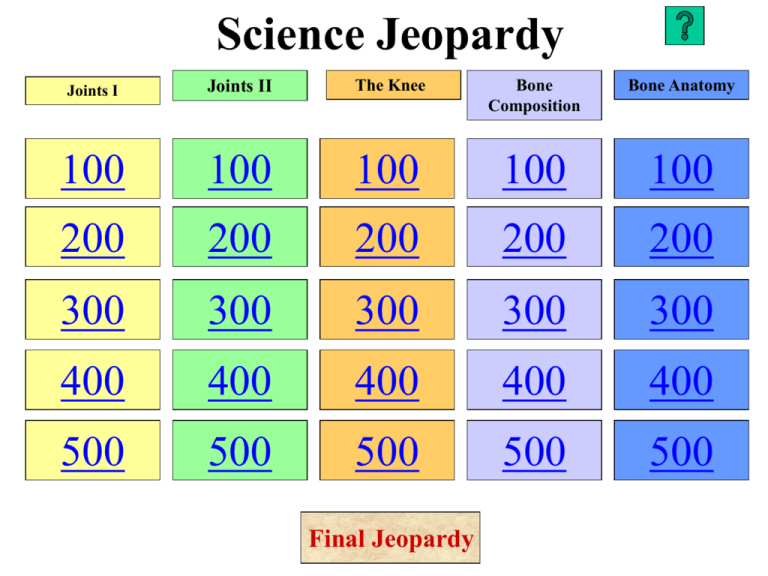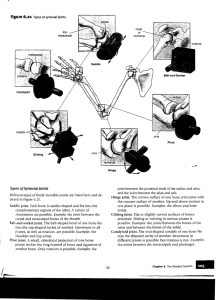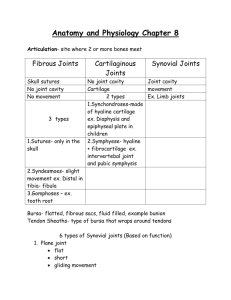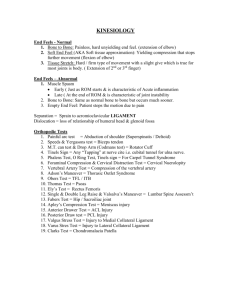ANSWER - Teacher Pages
advertisement

Science Jeopardy Joints I Joints II The Knee Bone Composition Bone Anatomy 100 100 100 100 100 200 200 200 200 200 300 300 300 300 300 400 400 400 400 400 500 500 500 500 500 Final Jeopardy FINAL JEOPARDY • ANSWER: Theory that describes how prokaryotes engulfed others to become more advanced. • QUESTION: What is the Endosymbiont Theory? Answer Question A-100 • ANSWER: Examples of fibrous or synarthritic joints • QUESTION: What are sutures,syndesmosis and gomphosis? Answer Question A-200 • ANSWER: Joint is within the tooth socket between the root of the tooth and the jaw bone. • QUESTION: What is a gomphosis? Answer Question A-300 • ANSWER: Joints between any cranial bones. • QUESTION: What are sutures? Answer Question A-400 • ANSWER: Joint between the first rib and the sternum and the growth plate. • QUESTION: What are synchondrosis joints? Answer Question A-500 • ANSWER: Examples are between the vertebrae and the two plevic bones. • QUESTION: What are symphysis? Answer Question B-100 • ANSWER: An example is the elbow. • • QUESTION: What is a hinge joint? Answer Question B-200 • ANSWER: where the ends of the phalanges meet with each other. • QUESTION: What are condyloid joints? Answer Question B-300 • ANSWER: Contains fluid, ligaments, tendons and articular cartilage • QUESTION: What are synovial joints? Answer Question B-400 • ANSWER: The joints of the wrist and ankle. • QUESTION: What are gliding joints? Answer Question B-500 • ANSWER: Examples are the hip and the shoulder. • QUESTION: What are ball and socket joints? Answer Question C-100 • ANSWER: Holds the knee cap in place. • QUESTION: What is the patellar tendon? Answer Question C-200 • ANSWER: Ligament attaches from the femur to the tibia. • QUESTION: What is the tibial collateral ligament? Answer Question C-300 • ANSWER: Ligament found in the interior knee joint. • QUESTION: What is the Anterior Cruciate Ligament or ACL? Answer Question C-400 • ANSWER: Cartilage found on the end of the tibia. • QUESTION: What is the meniscus? Answer Question C-500 • ANSWER: Ligament attached from the femur to the fibula. • QUESTION: What is the fibular collateral ligament? Answer Question D-100 • ANSWER: Cells that break down bone • QUESTION: What are oestoclasts? Answer Question D-200 • ANSWER:The bone cells • QUESTION: What are osteocytes? Answer Question D-300 • ANSWER: The cells that make bone. • QUESTION: What are osteoblasts? Answer Question D-400 • ANSWER: Type of bone found at the ends of a long bone. • QUESTION: What is epiphysis? Answer Question D-500 • ANSWER: Type of bone found at the middle of a long bone • QUESTION: What is diaphysis? Answer Question E-100 • ANSWER: hairlike canals that connect lacunae to each other and the central canal • QUESTION: What are canaliculi? Answer Question E-200 • ANSWER: small cavities in bone that contain osteocytes • QUESTION: What are lacunae? Answer Question E-300 • ANSWER: channels lying at right angles to the central canal, connecting blood and nerve supply of the periosteum to that of the Haversian canal • QUESTION: What are Volksman’s Cannals? Answer Question E-400 • ANSWER Central channel containing blood vessels and nerves. • QUESTION: What are Haversian Canals? Answer Question E-500 • ANSWER:weight-bearing, column-like matrix tubes composed mainly of collagen • QUESTION: What are lamella? Answer Question






